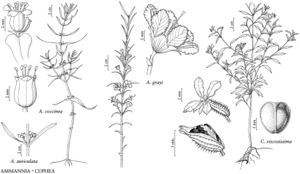Ammannia grayi
Harvard Pap. Bot. 18: 75. 2013.
Common names: Stalkflower
Basionym: Nesaea longipes A. Gray Smithsonian Contr. Knowl. 3(5): 68. 1852
Synonyms: Heimia longipes (A. Gray) Cory
Treatment appears in FNA Volume 10.
Herbs perennial, slender, 1–6 dm, glaucous throughout. Stems decumbent or trailing, branched or unbranched. Leaf-blades linear to narrowly lanceolate, 10–50 × 1–5 mm. Inflorescences solitary flowers; peduncle slender, 7–19 mm. Pedicels slender, 0.5–1 mm. Floral-tube campanulate, 3–6 mm; epicalyx segments shorter than sepals; sepals 6; petals 6, pale-pink or lavender, 4–7 × 3–5 mm; stamens (10–) 12 (–14); anthers green; style slender, well-exserted, 6–9 mm; stigma punctiform. Capsules 3.5 mm diam., included, circumscissile then splitting irregularly. 2n = ca. 50.
Phenology: Flowering late spring–fall (May–Sep).
Habitat: Limestone seeps along creek banks, on highly alkaline soil around springs and moist areas.
Elevation: 500–1500 m.
Distribution
N.Mex., Tex., Mexico (Coahuila), Mexico (Sonora)
Discussion
Selected References
None.
Lower Taxa
None.
... more about "Ammannia grayi"
perigynous +
green +
versatile +
brochidodromous +
membranous +
absent +
paired +
absent +
splitting +
circumscissile +
3.5 cm35 mm <br />0.035 m <br /> (?) +
included +
Stalkflower +
complanate +
ribbed +
green +
persistent +
splitting +
2-4-horned +
oily +
straight +
not developed +
8-12[-16]-ribbed +
green +
persistent +
perigynous +
campanulate +
bisexual +
absent +
trichomelike +
perennial +
glaucous +
Present +
indeterminate +
axillary +
1mm;5mm +
sessile +
opposite +
deciduous +
dimorphic +
rose-purple +
absent +
distinct +
axile +
superior +
bitegmic +
anatropous +
slender +
slender +
perigynous +
pinnately-veined +
caducous +
distinct +
globose +
Harvard Pap. Bot. +
2013 +
brown +
fleshy +
absent +
alternating +
valvate +
persistent +
incomplete +
equal +
anthocyanic +
young +
submerged +
4-angled +
thickened +
punctiform +
absent +
stout +
well-exserted +
slender +
unarmed +
glaucous +
Ammannia grayi +
Ammannia +
species +
aerenchymatous +
spongy +
splitting +
absent +
thin +
